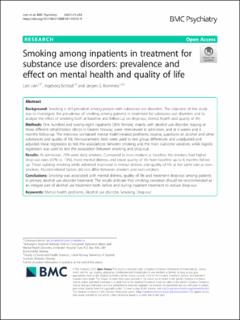| dc.description.abstract | Background: Smoking is still prevalent among people with substance use disorders. The objective of this study was to investigate the prevalence of smoking among patients in treatment for substance use disorders and to analyze the effect of smoking both at baseline and follow-up on drop-out, mental health and quality of life. Methods: One hundred and twenty-eight inpatients (26% female), mainly with alcohol use disorder, staying at three different rehabilitation clinics in Eastern Norway, were interviewed at admission, and at 6 weeks and 6 months follow-up. The interview contained mental health-related problems, trauma, questions on alcohol and other substances and quality of life. Non-parametric tests were used to test group differences and unadjusted and adjusted linear regression to test the associations between smoking and the main outcome variables, while logistic regression was used to test the association between smoking and drop-out. Results: At admission, 75% were daily smokers. Compared to non-smokers at baseline, the smokers had higher drop-out rates (37% vs. 13%), more mental distress, and lower quality of life from baseline up to 6 months followup. Those quitting smoking while admitted improved in mental distress and quality of life at the same rate as nonsmokers. Alcohol-related factors did not differ between smokers and non-smokers. Conclusions: Smoking was associated with mental distress, quality of life and treatment drop-out among patients in primary alcohol use disorder treatment. The results indicate that smoking cessation should be recommended as an integral part of alcohol use treatment both before and during inpatient treatment to reduce drop-out. | en_US |

